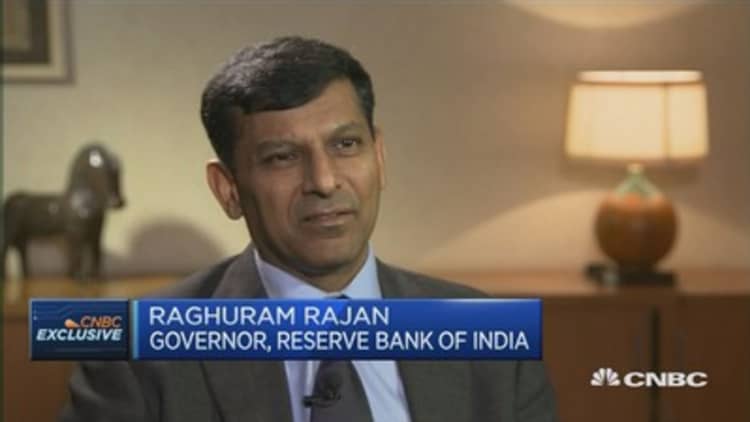
New Delhi ministers and economists alike are hoping for further monetary easing from the Reserve Bank of India (RBI) but in an exclusive interview with CNBC, central bank governor Raghuram Rajan hinted that any imminent rate cuts were unlikely.
A decline in food prices—long a thorn in the side of policymakers in Asia's third-largest economy—has helped cool inflation, bolstering expectations that India's central bank still has room to lower rates further from their current 6.75 percent.
But the central bank's policy scope may not be as ample as previously thought, according to Rajan.
"My sense is that the underlying inflation is between 5-5.5 percent right now, that's the sort of run rate, so we probably will get back to that by the end of the year," he told CNBC's Martin Soong.
"So, that doesn't give us a lot of room below the 6 percent [repo rate]. Our sense is that over the course of the next year, because of disinflationary forces and the weak state of the global economy, it will come close to 5 which is what we're targeting for March of 2017."
Read MoreInside the $1B swindle shaking India's banks
After averaging around 10 percent in 2013, consumer price inflation (CPI) stood at 4.41 percent in September, above August's 3.7 percent reading but still well within the central bank's targeted range. The RBI wishes to contain consumer price inflation (CPI) within 6 percent by January.
Citi economist Anurag Jha is forecasting inflation around 4.8 to 5 percent in the 2016-17 financial year after hitting 5.1 percent in October.
The RBI last cut its benchmark policy rate—the repo rate—by 50 basis points to 6.75 percent at the end of September in order to kick start the economy amid flagging economic indicators like industrial production, according to minutes of the monetary policy committee. So far this year, the RBI has lowered rates a total of four times by a cumulative 1.25 percent.
Finance minister Arun Jaitley has repeatedly told media that he hoped further cuts were on the table now that one of Asia's largest economies finally has inflation under control.
Cheaper oil has underpinned expectations for continued low inflation seeing as India is a net-energy importer. But while Rajan acknowledged the many benefits India receives from tumbling commodity prices, he's aware they could end anytime.
"It's a free pass but remember that what commodity prices do is affect the price of manufactured goods, remember that food inflation has somewhat been kept under check by agricultural commodities, which have held up. But where we're seeing some traction is in services inflation, which was the source of the high inflation earlier....we take all the luck we get, obviously there is some policy involved also."
On the topic of Prime Minister Modi's new gold monetization scheme, Rajan was confident that people would flock to the initiative.
Under the program, owners can store their yellow metal in banks and earn interest of 2.25-2.50 percent a year until it's withdrawn. Local media reports estimate Indians have more than $800 billion of the yellow metal in storage as the country surpassed China to become the world's largest gold buyer this year.
"It is an inflation protected bond in some sense—it is exposed to the gold price—but if you don't mind getting gold you are essentially buying gold in advance and getting an interest rate to boot, that looks like an attractive product especially for those saving for their daughter's wedding or their son's marriage or whatever, so that I think will be attractive," Rajan said.


